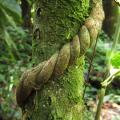
DMT-Nexus member

Posts: 3090 Joined: 09-Jul-2016 Last visit: 03-Feb-2024
|
I've got a theory that might help explain some peculiarities considering orally taken psychedelics.
-The experiential differences between chaliponga and other DMT-plants.
-The experiential difference between LSD-25, ALD-52, and 1P-LSD.
-The fact that sometimes some effects, like bodyload, stimulation, sedation, or nausea, can be felt even minutes after ingesting a hallucinogen, before the substance could even have reached the brain.
In short: the guts have their own, more or less, autonomous nervous system that is sometimes refered to as "the second brain". Many important receptors that are present within the brain, are also found in this "second brain". This nervous system, though somewhat autonomous, is constantly communicating with the brain. Communication is going in both directions. Some scientists even speculate that bacteria in the intestines may be a major contributor to psychiatric illnesses like depression or OCD.
So one of the main mechanisms of classic psychedelic drugs like DMT, is downregulation of 5-ht2-a. This is an autonomous process that is the result of what the brain perceives as overstimulation of this receptor.
My theory is: even before a classic hallucinogen has crossed the blood-brain barrier, it may have already affected the nervous system of the bowels. The bowels can then send a warning signal to the brain: "incoming serotonin receptor agonist" and thus prime the brain, to be ready to start downregulation. This priming signal could already cause some of the effects associated with psychedelics, like experiencing bodyload, stimulation and mild changes in perception.
Another consequence would be, that although 1P-LSD and ALD-52 are thought to be converted to LSD-25 when passing the blood-brain barrier, they may have their own unique effects on the nervous system outside of the brain. So then within the brain they act in the same way because they are the same substance, but outside of the brain they have different effects, that affect the way the brain responds to LSD-25.
And about chaliponga: ofcourse you could say that perceived differences in effect are the result of the placebo-effect, but that chaliponga also consistently produces diffent effects, physically....projectile vomiting being the most mentionable, is not realy something that can easily be disputed.
Tannins are thought to be the main cause of these physical typicalities.
My thought is that this whole "ejection process", even when it doesn't lead to actual vomiting, could be "jamming" the priming signal to the brain, and thus affecting the way the brain responds to DMT.
|
|
|
|
|

DMT-Nexus member
Posts: 1111 Joined: 18-Feb-2017 Last visit: 12-Jul-2024
|
I've never heard of Chaliponga causing vomiting. I don't vomit. There seem to be two types of Chaliponga, which look and smell the same, but have different effects. One produces the typical DMT effects, the other starts with DMT effects and some 3-4 hours later takes you to a very different headspace, which can be very ecstatic and numinous, but also very scary and it's impossible to surrender. It takes me to a place of hopelessness and despair. I've had an experience that destabilized me for many weeks, something that has never happened to me with any other DMT source. I'm aware that several sources of Chaliponga have been analysed and no other alkaloids than DMT have been found, but could it be that those batches were type 1, and type 2 can still contain other tryptamines (like 5-MeO-DMT)? dragonrider wrote:My theory is: even before a classic hallucinogen has crossed the blood-brain barrier, it may have already affected the nervous system of the bowels. The bowels can then send a warning signal to the brain: "incoming serotonin receptor agonist" and thus prime the brain, to be ready to start downregulation. This priming signal could already cause some of the effects associated with psychedelics, like experiencing bodyload, stimulation and mild changes in perception. And this may be a learned response, which would explain why people with more experience feel the effects of psychedelics quicker than first-timers. These days just the smell of Ayahuasca gives me lose bowels.
|
|
|

DMT-Nexus member
Posts: 112 Joined: 08-Apr-2017 Last visit: 04-Feb-2023
|
To me, LSD-25, ALD-52, and 1P-LSD have always felt the same. I was never able to tell the difference.
When I first started psychedelics, I didn't know what to expect so I never felt any nausea, bodyload, mental effects, or visuals until the drug properly kicked in. Once I was experienced with them, I felt it all relatively quickly, I just knew what was coming.
There's no doubt the gut influences the brain and I wouldn't doubt it if the gut had a larger role than we know in how these psychedelics affect us. I've read obtaining the proper gut bacteria could potentially cure things we don't have an answer for. It's an interesting theory and I hope more goes into it.
|
|
|

DMT-Nexus member
Posts: 467 Joined: 06-Sep-2015 Last visit: 06-Feb-2024 Location: in your mind
|
I am surprised with your statement ‘ The fact that sometimes some effects, like body load, stimulation, sedation, or nausea, can be felt even minutes after ingesting a hallucinogen, before the substance could even have reached te brain’. Reading this I get the impression that nausea should occur after the substance has reached the brain? I would think the nausea is originated in the stomach. In my experience the nausea is always felt long before the DMT has reached the brain. And in response to what Jagube says, I do agree with this. Only the smell of ayahuasca it enough to feel sick. Quiet the mind and the soul will speak
|
|
|

DMT-Nexus member

Posts: 3090 Joined: 09-Jul-2016 Last visit: 03-Feb-2024
|
strtman wrote:I am surprised with your statement ‘The fact that sometimes some effects, like body load, stimulation, sedation, or nausea, can be felt even minutes after ingesting a hallucinogen, before the substance could even have reached te brain’.
Reading this I get the impression that nausea should occur after the substance has reached the brain? I would think the nausea is originated in the stomach. In my experience the nausea is always felt long before the DMT has reached the brain.
And in response to what Jagube says, I do agree with this. Only the smell of ayahuasca it enough to feel sick. Yes, some forms of nausea. But people sometimes experience a form of nausea that is more like motion sickness. Furthermore, i would say that the phenomena of experiencing bodyload, and stimulation or sedation, are normally seen as products of the brain by most people. Many people report feeling stimulation, minutes after ingesting LSD or another psychedelic. Way before the first psychedelic effects become noticeable. With LSD it is more typically stimulation. With mushrooms or other psychedelics, some people also experience a mild sedative effect sometimes.
|
|
|

DMT-Nexus member

Posts: 3090 Joined: 09-Jul-2016 Last visit: 03-Feb-2024
|
LongTimeWaiting wrote:To me, LSD-25, ALD-52, and 1P-LSD have always felt the same. I was never able to tell the difference.
When I first started psychedelics, I didn't know what to expect so I never felt any nausea, bodyload, mental effects, or visuals until the drug properly kicked in. Once I was experienced with them, I felt it all relatively quickly, I just knew what was coming.
There's no doubt the gut influences the brain and I wouldn't doubt it if the gut had a larger role than we know in how these psychedelics affect us. I've read obtaining the proper gut bacteria could potentially cure things we don't have an answer for. It's an interesting theory and I hope more goes into it. Recently somebody made a post about 1P-LSD. I don't exactly recall it, but it came down to it having very strong stimulant effects on him. So much so even, that he worried about the safety of it for people with cardio-related health problems. And i personally have experienced something simmilar. 1P-LSD is a much more potent stimulant for me, than LSD or ALD-52. I find these lysergamides very simmilar. But there are some small differences for me. And the onset of especially 1P-LSD is very different for me. The peak is very much the same as the others, but i find the onset of 1P rather unpleasant. It feels like i just drank too much strong coffee. I think this is a metabolic issue. Some people say that 1P always works very quickly for them. But for me it normally takes two hours and thirty minutes for it to work. During these last two hours the unpleasant stimulant effects build-up and then suddenly subside after T 2.30. But even then, it is still a little different for me. Initially, when i first discovered 1P-LSD, i was surprised at how simmilar 1P was to LSD itself. But after having taken it more than a dozen times now, i now think 1P-LSD is slightly more visual for me than LSD-25 and ALD-52. As 1P-LSD converts to LSD when passing the brain-blood barrier, the differences can only be explained by the effects of 1P outside of the brain. I think 1P-LSD agonises some receptors outside of the brain, and that these receptors then send signals to the brain, that modulate the effects of LSD in the brain.
|